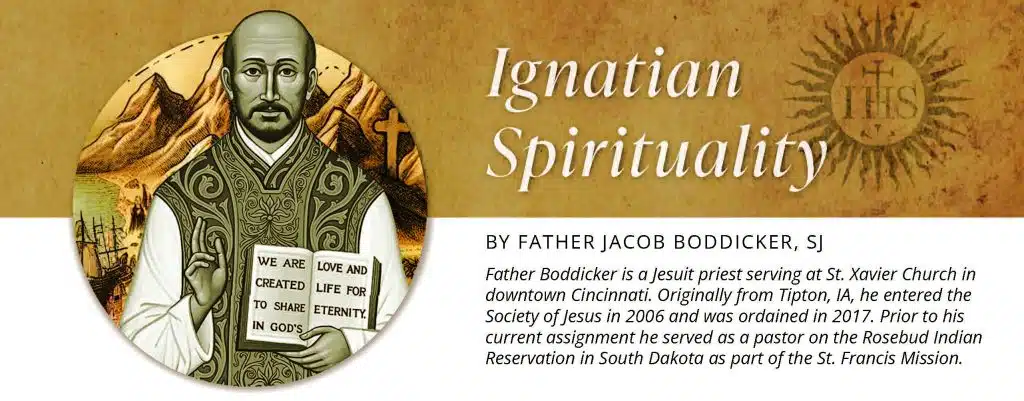Catholic Spirituality: Ignatians
 On May 20th, 1521, a fiery young man named Íñigo López de Oñaz y Loyola—better known to us as St. Ignatius of Loyola—was injured in a battle at Pamplona in Spain. In the long months of bedrest and boredom during his convalescence, Ignatius either daydreamed about great romances and adventures or read and reflected upon two books given to him—on the life of Christ and the lives of the saints. Noticing the romantic fantasies ultimately felt hollow and boring, while reflecting on Christ and the saints kept him energized and satisfied even after he completed them, he paid careful attention to his interior movements. By the time he was back on his feet—enduring a permanent limp from his injuries—he forsook his nobility and wealth and made his way as a poor pilgrim and beggar.
On May 20th, 1521, a fiery young man named Íñigo López de Oñaz y Loyola—better known to us as St. Ignatius of Loyola—was injured in a battle at Pamplona in Spain. In the long months of bedrest and boredom during his convalescence, Ignatius either daydreamed about great romances and adventures or read and reflected upon two books given to him—on the life of Christ and the lives of the saints. Noticing the romantic fantasies ultimately felt hollow and boring, while reflecting on Christ and the saints kept him energized and satisfied even after he completed them, he paid careful attention to his interior movements. By the time he was back on his feet—enduring a permanent limp from his injuries—he forsook his nobility and wealth and made his way as a poor pilgrim and beggar.
For a year he lived in nearby Manresa, spending several months praying and fasting in a nearby cave, sometimes praying up to seven hours a day. During this time he developed what would become his famous Spiritual Exercises.
Because the importance of his own personal experience came to form the DNA of Ignatius’ spirituality, personal experience is the very matter of such Ignatian practices as the Daily Examen, the Spiritual Exercises and even Ignatian Contemplation. He came to understand that God is not only constantly laboring on our behalf, but also desires that we labor with
Him. Ignatian spirituality seeks to discern and notice God present and laboring in our everyday lives, such that in becoming more attentive to His Spirit’s movements in our hearts and souls, we come to know how He desires us to serve alongside Him. By this we come to know Jesus on a deeply personal level, in a relationship such as the apostles themselves enjoyed, that not only may we come to know and love Him, but we might likewise go into the world and make Him known to others; speaking not only from our knowledge of the faith, but our lived experience of Him.
How does one practice Ignatian Spirituality? There are many online resources, but the fundamental practice—so important that St. Ignatius exhorts a Jesuit never to miss practicing it, no matter how busy he may be—is that of the Daily Examen. Find a place that is quiet and conducive to prayer, and set aside five, 10, 15 minutes, or whatever brief time you have. Then:
1. Place yourself in God’s presence, and thank Him for everything He has done for you.
2. Ask Him to enlighten your mind, heart and soul to better notice and understand how He has been at work in your life.
3. Review your day, or since the last time you prayed the Examen, until the present moment. Recall specific moments and what you experienced in them.
4. Reflect on some of those specific experiences: Where did you experience God’s presence and love; how did you respond? Where did you experience His absence, distance; where did you move away from Him? Ask His forgiveness for any moments of sin.
5. Look ahead to tomorrow: What are you anxious about or looking forward to? What do you want His help with or want to talk to Him about? Make a resolution about how you plan to confront one future thing with His help.
6. Conclude by praying the “Our Father.”













